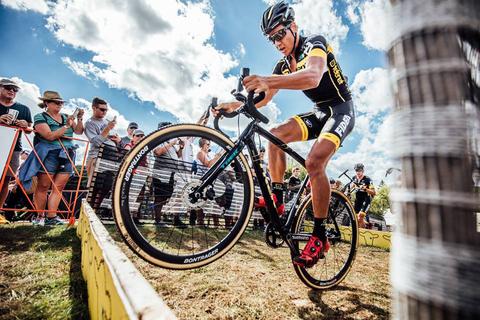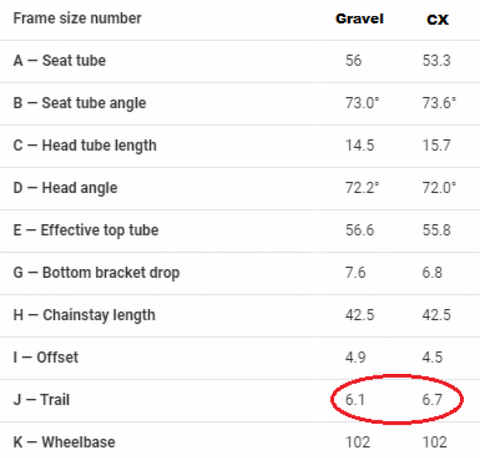
With the winter weather here, many people are packing away their pride and joys and wheeling out their winter steeds that are equipped with mudguards ready to take on the worst that weather can throw at them. However, more and more riders are starting to venture off the beaten track and head off road, exploring the byways and bridle paths to get away from the increasingly busy roads or extending the race season by entering the local cyclocross league. Either way, many people are looking at investing in a off road capable road bikes because, in addition to being a lot of fun off road, they can double up as a great winter training bike by installing some mudgaurds and some slick tires. But there are two distinctively different options available: Gravel bikes and Cyclocross bikes. So how do they differ, and which is right for you?

Cyclocross has been around since the early 20th century and involves short races of around an hour off road around a technical circuit of grass and mud which includes obstacles like planks, stairs, tight turn and banks where it is often quicker to shoulder the bike and run rather than ride. However, there are rarely any rocks or jumps involved like in mountain biking. Rules and regulations have meant that there is a limit to the width of the tires (33mm). The bikes tend to be very focused on the requirements for cross racing and don’t always have mudguard mounts.

Gravel is a category of bikes that has exploded in recent years. It started in the USA where they have lots of graded gravel roads heading out into the middle of nowhere. Gravel bikes tend to have clearance for much bigger volume tires because they need the ability to absorb the impact on bigger rocks etc. The bikes tend to be very versatile and capable of being equipped with slick tyres and mudgaurds in a winter road bike form, racks if you want to go touring or stripped back with knobbly tires if you want to go for a back country blast.

The biggest difference between a gravel bike and a cyclocross bike is in the geometry. As you can see when we compare 56cm frame from Trek’s gravel bike, the Checkpoint, to their cyclocross bike, the Boone:


In cyclocross, you need the bottom and pedals to be slightly higher off the ground to allow riders to clear obstacles and traverse off camber banks without hitting the pedals. The Boone is therefore 8mm higher at the bottom bracket compare to the Checkpoint. The Checkpoint geometry is much closer to a road bike like the Trek Domane.


Cyclocross bikes tend to be a bit steeper in the seat tube to push the saddle further forward and therefore put more body weight on the front wheel for more grip. The Boone is 0.60 steeper which might not sound much, but it’s enough to make a significant difference to saddle position. Again, the Checkpoint is close in geometry to a road bike like the Domane.

These two aspects mean that, compared to a road bike, you feel like you’re perched “on top” of a cyclocross bike where as you “sit in” the gravel bike more like a road bike.

While both the Checkpoint and the Boone have the same chainstay lengths and thus the rear ends should behave similarly, the front ends differ. This is particularly apparent when we look at the trail measurement. This is the measurement of where the ground contact point is behind a line that is drawn through the centre of rotation of the head tube. This can be manipulated by changing both the head tube angle and fork offset.

A simple way to think about this is looking at the front wheels of a shopping trolley which has a lot of trail and when you push the trolley forward, the wheels naturally rotate to a straight-ahead position. Therefore, a bike with a bigger trail measurement is going to be more stable and but require more effort to turn. Stability is what you want off road and therefore the cyclocross bike has a larger trail measurement. Again, the Checkpoint has a trail measurement that is closer to a road bike and will thus handle more like a road bike when you’re back on the hard stuff.

Well…. Yes and no. The more stable front end will be slightly easier to control in the slimy conditions. However, the two biggest areas that make a bike good in the mud are tyre selection and mud clearance.
In the mountain bike world, mud specific tires tend to have longer nobbles to dig deep into the mud and they are more widely spread to aim in mud shedding. Mud tyres tend to also be narrower because the smaller surface area results in a higher contact pressure which digs the tire deeper into the mud.
Because the racing regulations dictate that a cyclocross bike can’t have tyres wider than 33mm, out of the box it will grip better in mud than a gravel bike with 40mm tyres because the narrower tire will cut deeper into the mud.
However, because the gravel bike is designed to accommodate 40mm+ tyres, they have copious amounts of mud clearance once you install a thinner mud tyre. Therefore, if equipped with correct the correct tyre for the conditions, a gravel bike will be just as, if not more capable in muddy conditions.
In addition to mud clearance, the added real estate through the forks and stays means that you can run a sizeable mudguard on a gravel bike if you’re using it as a winter road bike.

The question you’ve got to ask yourself is: How much off road are you going to be doing? If you’re wanting to race cyclocross, ride off road and only occasionally use the bike on road, buy a cyclocross bike. However, if you’re looking for a versatile steed that can munch the byways and green lanes, dabble in a bit of cross racing but then take to the roads with a good volume slick tyre and mudguards for the winter club runs and a rack for the winter commutes: that’s a gravel bike through and through.
If you’re thinking about getting set up for some winter riding, give us a call on 01223 500502. We have both cyclocross and gravel options available from Trek, Cervelo, Moots, Cinelli, 3T and more.